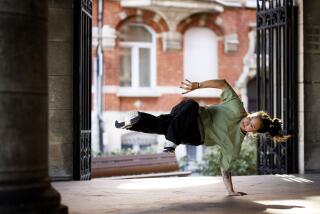Holiday pounds? Give ‘em a swift kick
- Share via
When most of us think of the French, street fighting is hardly what springs to mind. Cheese, wine and art, mais bien sur. But martial arts? Not so much.
So when I stumbled across a French form of kickboxing called savate while channel surfing one night, I knew I had to check it out. One quick Web search turned up half a dozen different classes in the area. Quelle surprise! There’s a thriving community of savateurs in Los Angeles.
In fact, my jaw nearly hit the floor when Nicolas Saignac, 42, a former French Cup champion who teaches savate classes at Bodies in Motion in West Los Angeles, handed me an article about French boxing that ran on the front page of the Los Angeles Times on Sept. 11, 1892.
Savate, also called la boxe francaise, is one of the only martial arts to emerge from the West. But Asian martial arts and English boxing have eclipsed it, in part because so many savate masters were wiped out in the first two world wars. “People don’t know about it, but the U.S. Army used to train in savate,” Saignac says.
After one class, I could see why. If you want to drop some holiday pounds -- heck, if you’re looking for a cardio workout that’s one step away from a heart attack, savate may be for you. Even though I rollerblade and hike frequently, savate made my face turn, as the French say, rouge comme une tomate. I actually thought I might pass out. Such hard-core conditioning is crucial to savate because fighters stay in constant motion to avoid getting hit or kicked.
“Savateurs really pride ourselves on being able to get out of the way,” Saignac says.
Savate, now an amateur competitive sport with weight divisions and a ranking system of glove colors, originated as a form of bloody street fighting among hoodlums in France. Noblemen civilized it in the late 19th century, combining techniques of English boxing with elegant but brutal kicks to the head, gut and legs. (Savate also includes a form of cane fighting called la canne, although this is generally taught separately now.)
It’s performed with shoes on -- which makes it different from other types of kickboxing.
“We emphasize harassing the opponent with multiple kick combinations at every level to confuse him,” says Salem Assli, president of the California Assn. of B.F. Savate, who teaches at Inosanto Academy of Martial Arts in Marina del Rey. “There’s a great deal of footwork. Other martial artists find it hard to deal with the savateur. It’s very frustrating because it’s all over the place.”
Consider taking various savate classes before deciding what you think of it. The ones I attended at Bodies in Motion and Inosanto were very different. Saignac’s class, held three times a week, focuses on aerobic conditioning. (He also trains a small group of competitors in the finer points of savate outside of regular class hours.) Assli’s class, held Saturdays, emphasizes technique and partner sparring.
And the School of Savate in West Hollywood -- where I didn’t get to try a class -- is run by none other than Michael Giordani, who last year became the first and only U.S. fighter to win a full-contact fight in the world championships.
At Bodies in Motion on a recent Friday, Saignac’s class was filled with floor-to-ceiling punching bags, and about a dozen people -- only two of them men -- were warming up. Savate tends to appeal to women because it is less bruising than, say, Thai boxing, which allows fighters to use their shins and elbows.
Saignac taped up my hands and handed me a pair of boxing gloves. Once the music started thumping, we didn’t slow down for the next hour: There was no false advertising when they named the place Bodies in Motion. Following Saignac’s lead, I started kicking the bag low and high, followed by three punches in rapid succession, jumping around on my toes in between. Kick-kick, punch-punch-punch. Kick-kick, 1-2-3.
After a few minutes with one combination, Saignac demonstrated a second set of moves, and the whole room switched without missing a beat. We did side kicks, round kicks, front kicks and reverse kicks. At one point, two of us circled around, taking shots as if fighting one another through the bag.
Saignac didn’t stop to explain much, although he walked around recommending a few minor course corrections. He urged me to breathe out while I punched and to keep my distance from the bag until I was ready to move in for an attack.
Twice in the middle of class, we dropped to the floor for push-ups. Down for 20, then we bounded up again for more kicking and punching. I thought I would die by the time we hit the ground for a final few minutes of abdominal work. I don’t think I’ve ever viewed sit-ups with such relief.
Massage therapist Mary Frances Person, 33, who attended the class, says she was “amazed almost to the point of horror” by the intensity of her first savate class at Bodies in Motion nine years ago, despite being a brown belt in another martial art. Today she’s one of several champions from the Los Angeles area, tying for third in this year’s world championships and placing second in 2002.
“This is all cardio,” Person says. “You’re always on your toes, always moving because you’re trying to make your opponent think you’re one place when you’re not.”
When I unwrapped my hands after class, the blood vessels in my knuckles had burst and my calves and lateral muscles were shot. But I still managed to crawl out of bed the next day to make my way to Assli’s class at Inosanto.
Initially, the gym looked intimidating. The gender ratio was the exact reverse of that at Bodies in Motion, two women and 10 men. But Assli was very helpful, and we got some precious moments of rest while he demonstrated and explained techniques.
The cardio was not as intense at Inosanto, but I got to fight with a partner, which is much more fun than pummeling a bag. Rather than teaching one technique at a time, Assli threw us complex combinations and let us dive right in. When I stood there looking clueless, my partner, Jeff Rousso, 53, a real estate developer, was nice enough to help break it down for me. In minutes, I was throwing and parrying punches, kicking and evading kicks -- lightly, so it didn’t hurt.
I learned the names of some of the moves: jabs, crosses and hooks, the old 1-2-3, plus uppercuts. I learned how to stand, how to protect my face and my body, how to lift a leg to evade a low kick or to duck under a punch.
Within the hour, I was performing a crazy combination of two side kicks with the left leg, which Rousso blocked with pads, followed by a jab-cross-jab. I then evaded his punch by ducking, throwing another left-right-left before making two more side kicks with the right leg.
Assli also made us hop around on our left leg while throwing as many different kicks in a row with our right leg (no touching the ground) until we were too exhausted to hold it up. Years of gymnastics training helped with this exercise. Assli and Person were also competitive gymnasts before they became savateurs, and both sports require a similar combination of balance, flexibility, precision, strength and endurance.
“When you come from gymnastics, you can do anything,” Assli says.
Just when I started to feel cocky, I realized how much I had to learn -- namely, how to aim. Attempting a spinning reverse kick to Rousso’s thigh, I missed and hit his groin. Oops. “That’s why I wear the cup,” he says. Not a bad move to remember on a date gone sour, though.
Despite similarities to other martial arts, savate is distinctly French.
“It’s so elegant, so precise and so ... I’m probably going to get in trouble for saying this, but the best people do it with a little flair and attitude,” says Person, former president of the U.S. Savate Federation. “How many times can I hit you as beautifully as possible without being touched?”
Even the names of savate kicks sound graceful; many were borrowed from the names of ballet moves. The side kicks are called chasses and round kicks fouettes, performed by snapping the leg like a whip. Watching a skilled savateur leap through the air with straight, extended legs and pointed toes is a bit like watching Mikhail Baryshnikov dance “The Nutcracker.”
But don’t let the beauty fool you. “It’s like a deadly ballet,” Assli said. One full-contact kick to the chest or head, and you’ll need a stretcher.
After two days of practicing savate, what I really needed was a good meal. I worked up such an appetite that I decided to venture out for the tasting menu at the French restaurant Melisse in Santa Monica. So much for all those calories burned. But then again, French women don’t get fat, right? If that’s so, I think I finally know why. Savate must be their real secret.
*
To find out more
* www.calsavate.com
* Bodies in Motion
12100 Olympic Blvd.
Los Angeles, CA 90064
(310) 836-8000
www.bodiesinmotion.com
* Inosanto Academy of Martial Arts
13348-13352 Beach Ave.
Marina del Rey, CA 90292
(310) 578-7773
www.inosanto.com
* School of Savate
7327 Santa Monica Blvd.
West Hollywood, CA 90046
Contact: Michael Giordani
(310) 804-1334
-- Jenny Hontz
More to Read
Go beyond the scoreboard
Get the latest on L.A.'s teams in the daily Sports Report newsletter.
You may occasionally receive promotional content from the Los Angeles Times.










